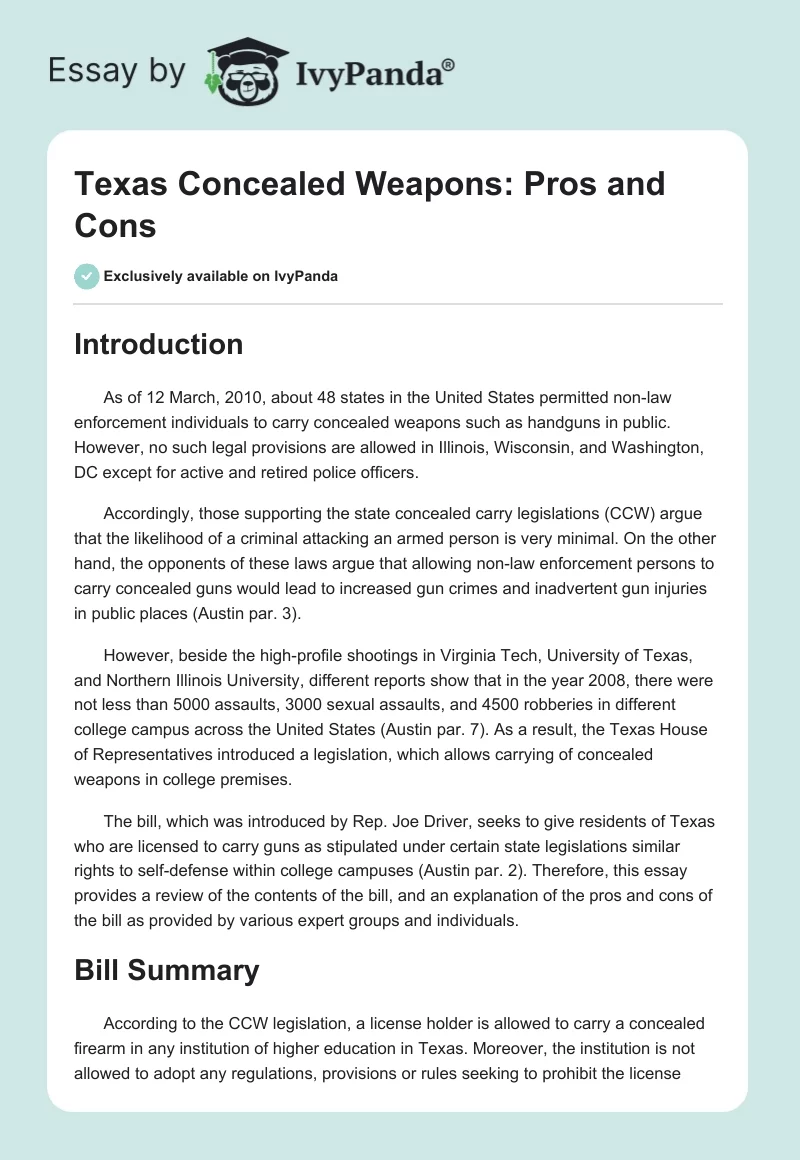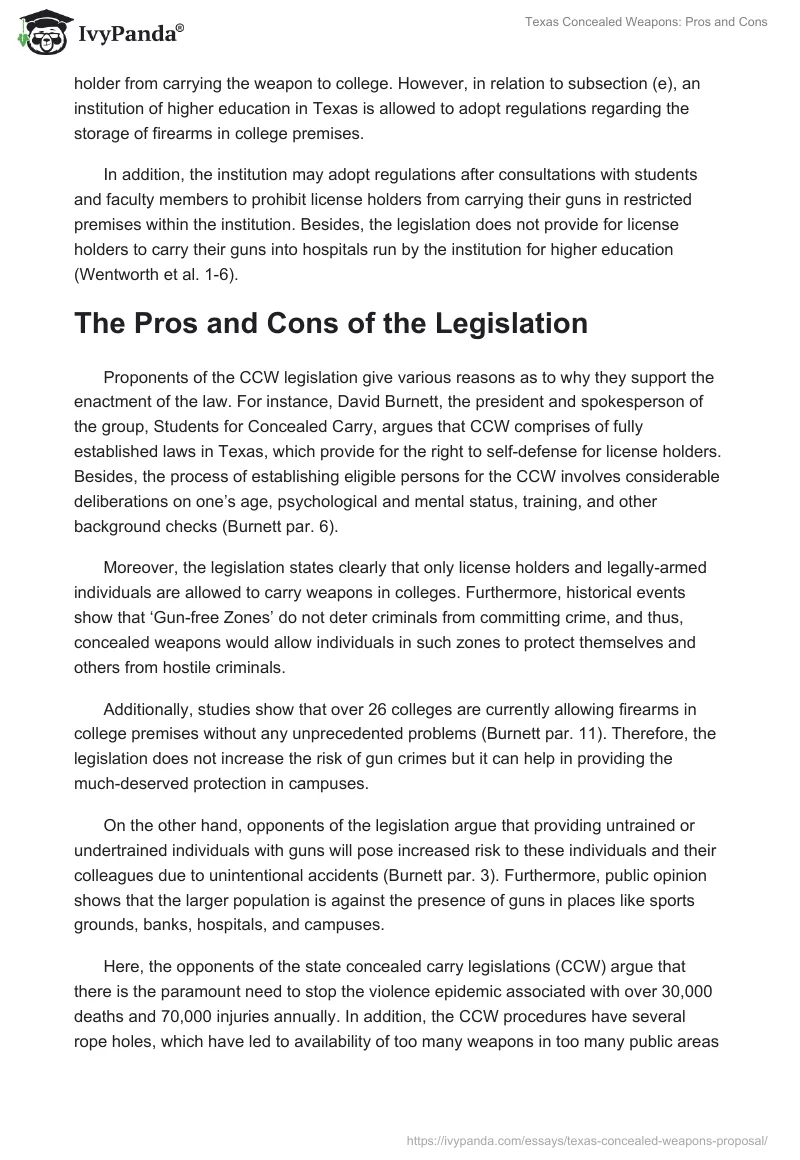Introduction
As of 12 March, 2010, about 48 states in the United States permitted non-law enforcement individuals to carry concealed weapons such as handguns in public. However, no such legal provisions are allowed in Illinois, Wisconsin, and Washington, DC except for active and retired police officers.
Accordingly, those supporting the state concealed carry legislations (CCW) argue that the likelihood of a criminal attacking an armed person is very minimal. On the other hand, the opponents of these laws argue that allowing non-law enforcement persons to carry concealed guns would lead to increased gun crimes and inadvertent gun injuries in public places (Austin par. 3).
However, beside the high-profile shootings in Virginia Tech, University of Texas, and Northern Illinois University, different reports show that in the year 2008, there were not less than 5000 assaults, 3000 sexual assaults, and 4500 robberies in different college campus across the United States (Austin par. 7). As a result, the Texas House of Representatives introduced a legislation, which allows carrying of concealed weapons in college premises.
The bill, which was introduced by Rep. Joe Driver, seeks to give residents of Texas who are licensed to carry guns as stipulated under certain state legislations similar rights to self-defense within college campuses (Austin par. 2). Therefore, this essay provides a review of the contents of the bill, and an explanation of the pros and cons of the bill as provided by various expert groups and individuals.
Bill Summary
According to the CCW legislation, a license holder is allowed to carry a concealed firearm in any institution of higher education in Texas. Moreover, the institution is not allowed to adopt any regulations, provisions or rules seeking to prohibit the license holder from carrying the weapon to college. However, in relation to subsection (e), an institution of higher education in Texas is allowed to adopt regulations regarding the storage of firearms in college premises.
In addition, the institution may adopt regulations after consultations with students and faculty members to prohibit license holders from carrying their guns in restricted premises within the institution. Besides, the legislation does not provide for license holders to carry their guns into hospitals run by the institution for higher education (Wentworth et al. 1-6).
The Pros and Cons of the Legislation
Proponents of the CCW legislation give various reasons as to why they support the enactment of the law. For instance, David Burnett, the president and spokesperson of the group, Students for Concealed Carry, argues that CCW comprises of fully established laws in Texas, which provide for the right to self-defense for license holders. Besides, the process of establishing eligible persons for the CCW involves considerable deliberations on one’s age, psychological and mental status, training, and other background checks (Burnett par. 6).
Moreover, the legislation states clearly that only license holders and legally-armed individuals are allowed to carry weapons in colleges. Furthermore, historical events show that ‘Gun-free Zones’ do not deter criminals from committing crime, and thus, concealed weapons would allow individuals in such zones to protect themselves and others from hostile criminals.
Additionally, studies show that over 26 colleges are currently allowing firearms in college premises without any unprecedented problems (Burnett par. 11). Therefore, the legislation does not increase the risk of gun crimes but it can help in providing the much-deserved protection in campuses.
On the other hand, opponents of the legislation argue that providing untrained or undertrained individuals with guns will pose increased risk to these individuals and their colleagues due to unintentional accidents (Burnett par. 3). Furthermore, public opinion shows that the larger population is against the presence of guns in places like sports grounds, banks, hospitals, and campuses.
Here, the opponents of the state concealed carry legislations (CCW) argue that there is the paramount need to stop the violence epidemic associated with over 30,000 deaths and 70,000 injuries annually. In addition, the CCW procedures have several rope holes, which have led to availability of too many weapons in too many public areas (Burnett par. 7). As a result, there is the need to limit access to guns in order to minimize crime and accidents in public places.
Conclusion
From the foregoing discussions, we note that the state concealed carry legislation (CCW) has many benefits as well as shortcomings, which are worth the attention of the authorities responsible. However, the fact that most colleges are unable to provide sufficient protection to all students cannot be overstated.
Moreover, claims that colleges are much safer than most cities and urban establishments do not hold considering that currently, cases of crime, sexual assaults, and killings are on the rise in most institutions for higher education in the US. As a result, if these institutions have failed in providing security to students and faculty members, then there is no need to deprive them of their right to self-defense. Therefore, there will be a net positive impact in most colleges in Texas upon enactment of the legislation.
Works Cited
Austin, Mark. Texas leads nation with campus carry bill. ConcealedCampus. 2011. Web.
Burnett, David. Concealed guns: should adults have the right to carry a concealed handgun? Santa Monica, CA: ProCon. 2010. Web.
Wentworth, et al. S.B. No. 1164: an act relating to the carrying of concealed handguns on the campuses of the institutions of higher education. The legislature of the State of Texas, n.d. Web.


